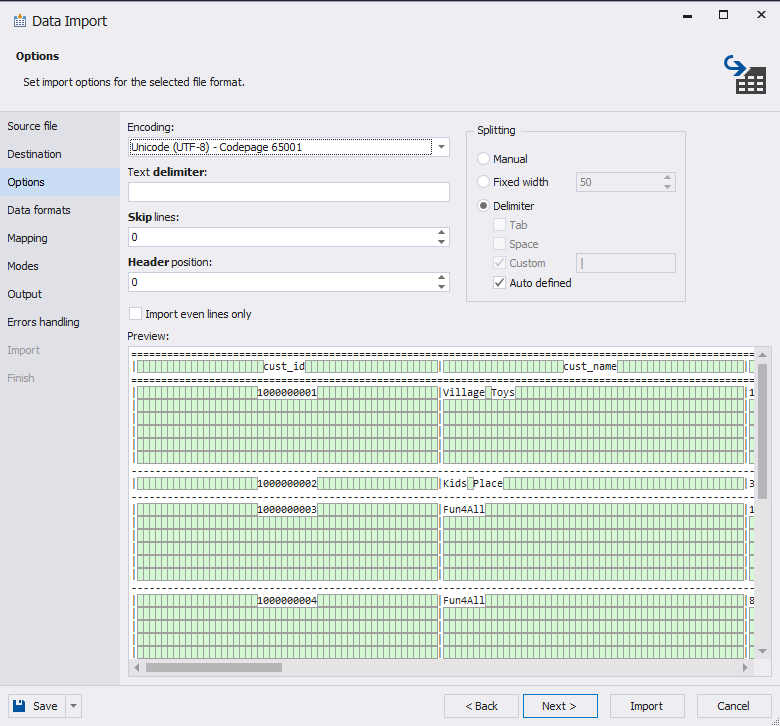Text Import
This topic describes how to import data from a TXT file.
Note
Data Import Wizard pages can slightly differ due to the product you have been using.
-
Decide what table to import the data to:
For a new table:
- On the Database menu, click Import Data. The Data Import wizard opens.
For an existing table:
- In the Database Explorer, right-click a table and select Import Data on the shortcut menu. The Data Import wizard opens with predefined parameters: a Oracle connection, a database, and a table to import the data to.
-or-
- On the Database menu, click Import Data, and select a required table on the Destination table wizard page.
- On the Data Import > Source file tab, select the Text import format, specify a location of Source data, and click Next.
-
On the Data Import > Destination tab, specify an Oracle connection, a database, and a table to import the data to, and then click Next.
Note
If you selected a table in Database Explorer before opening the Data Import wizard, the wizard will open with the predefined connection parameters of the selected table.
To create or edit Oracle connections, use the corresponding options.
-
On the Data Import > Options tab, specify how you want to split the Source data into columns:
- Manual - for manual splitting. In the Preview section, double-click desired positions to set column ranges. The markers will appear. You can move them forward or backward to change the columns length. To remove the markers, double-click them.
- Fixed width - to split into columns with fixed width. Specify a width value and see how the Source columns are splitted in the Preview section.
- Delimiter - requires you to specify a column delimiter. See the result in the Preview section.

- On the Data Import > Data formats tab, adjust data formats for the Source data and click Next.
-
On the Data Import > Mapping tab, map the Source columns to the Target ones. If you are importing the data into a new table, dbForge Studio will automatically create and map all the columns. If you are importing into an existing table, only columns with the same names will be mapped, the rest should be mapped manually. (If no columns with the same name are found, they are mapped in succession - the 1st column in Source with the 1st column in Target, etc.)
You can see the Target columns in the top and the Source columns at the bottom of the wizard page. To change automatic mapping, do the following:
- (for columns split with a delimiter) Click the Source column fields on the top grid and select required columns from the drop-down list.
- (for columns with fixed width or manual splitting) Select a Target column in the top grid and click Unmap. To map it to a Source column, click a required one at the bottom grid and click Map. The length and starting position values of the Source column will appear in the corresponding fields in the top grid. If required, you can change these values manually.
Note
To cancel mapping of all the columns, click Clear Mappings on the toolbar. To restore it, click Fill Mapping.
If you are importing to a new table, you can edit the Target column properties by double-clicking them on the top grid. Select the Key check box for a column with a primary key and click Next. Note that you should select at least one column with a primary key, otherwise some of import modes on the Modes wizard page will be disabled.
- On the Data Import > Modes tab, select an import mode to define how dbForge Studio should import the data, and then click Next.
-
On the Data Import > Output tab, select output options to manage the data import script and click Next:
- Open the data import script in the internal editor
- Save the data import script to a file
- Import data directly to the database
- On the Data Import > Errors handling tab, select the way to handle errors during import, specify logging options, and click Import.
- On the progress page, dbForge Studio will notify you whether the import completed successfully or failed. To view the log file, click Show log file.
-
To close the wizard, click Finish.
Note
You can save the import settings as a template for later use. To save the selected settings, click Save on any wizard tab. Next time you should only select a template and specify a location of the Source data - all the settings will be already set. For more information about how you can save templates, see Saving and Using Templates.